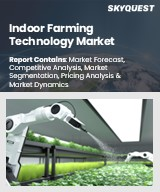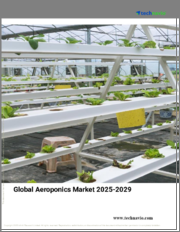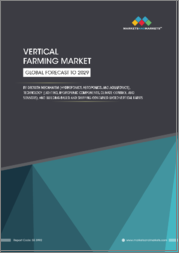
|
시장보고서
상품코드
1587635
세계의 에어로포닉스 시장 예측 : 컴포넌트별, 기술별, 용도별, 최종 사용자별, 지역별 분석(-2030년)Aeroponics Market Forecasts to 2030 - Global Analysis By Component (Lighting, Sensors, Nutrient Delivery System, Irrigation System, Growth Chamber, Climate Control Systems and Other Components), Technology, Application, End User and By Geography |
||||||
Stratistics MRC에 따르면 세계 에어로포닉스 시장은 2024년에 21억 달러로 추정되고, 예측 기간 동안 CAGR 27.6%로 성장할 전망이며, 2030년에는 92억 달러에 이를 전망입니다.
에어로포닉스는 안개나 공기가 많은 환경에서 식물을 재배하기 위한 물 효율이 뛰어난 무비료 재배 기술입니다. 식물을 흙이나 물에 담그지 않고 중요한 영양소, 물, 산소를 뿌리에 직접 공급합니다. 이 방법은 사용하는 물의 양이 적고 식물의 발육을 빠르게 하며, 수확량을 늘릴 수 있기 때문에 환경 친화적이고 지속 가능합니다. 에어로포닉스는 온도, 습도, 양분을 정확하게 관리할 수 있어 온실이나 수직 농장 등의 관리된 환경에 이상적입니다.
유엔 인구부(2009년)에 따르면 세계 인구는 2010년 약 69억명에서 2050년에는 92억명으로 증가할 것으로 예상되고 있습니다. 현재 세계 인구의 증가율은 연간 8,000만 명 가까이입니다. 지구상의 거주 가능한 면적은 130억 헥타르 가까이에 한정되어 있기 때문에 이것은 큰 우려입니다.
유기농 무농약 농산물에 대한 소비자의 선호도 증가
건강 지향 소비자는 영양분이 풍부하고 농약을 사용하지 않는 제품을 찾고 있으며, 유기농 작물에 대한 수요가 높아지고 있습니다. 에어로포닉스는 물 소비량이 최대 95% 적고 화학비료가 필요하지 않기 때문에 생태계에 미치는 영향과 환경의 지속가능성을 우려하는 소비자들에게 매력적이며, 이것이 이 동향을 뒷받침하고 있습니다.
규모 확대의 과제
에어로포닉 시스템용 특수 설비에 대한 초기 비용이 높기 때문에 신흥 기업과 소규모 농업 종사자들은 사업의 도입과 확대를 단념할 가능성이 있습니다. 사업이 확대됨에 따라 이러한 시스템의 기술적 복잡성은 식물 생물학과 정확한 비료 관리에 대한 철저한 이해를 필요로 하며 효율적인 모니터링 및 유지보수를 위해 자격을 갖춘 직원이 필요해 시장 성장을 방해합니다.
경작지 감소
농지는 도시화와 인구 증가로 감소하고 있으며, 에어로포닉스와 같은 최첨단 농업 기술의 사용이 필요합니다. 에어로포닉스는 제약이 많은 곳에서도 고밀도 작물 생산을 가능하게 하기 때문에 도시의 식량 안보에 매력적인 선택입니다. 에어로포닉스 및 기타 지속 가능한 농업 기술은 기존의 농법에 비해 사용하는 물과 토지의 양이 최대 95% 적고 지속가능성의 목표에 부합합니다.
정전 및 시스템 고장에 대한 취약성
정전 및 장비 고장은 안개에 의한 안정적인 질소 공급에 의존하는 에어로포닉 시스템에서 재배되는 작물에 해를 끼칠 수 있습니다. 이러한 위험은 뿌리가 건조하거나 식물에 해를 끼칠 수 있으므로 생산자가 이러한 시스템에 대한 투자를 단념할 수 있습니다. 소규모 생산자와 시장 진입 가능성이 있는 생산자는 이러한 위험을 줄이기 위해 사업자가 자주 투자해야 하는 백업 전원 시스템을 구입할 여유가 없다는 것을 알 수 있습니다.
COVID-19의 영향
COVID-19의 유행은 에어로포닉스 시장에 다양한 영향을 미쳤습니다. 처음에는 세계 공급망의 혼란이 생산과 유통에 영향을 미쳤습니다. 그러나 팬데믹은 지속가능하고 효율적인 농업 관행에 대한 관심을 높여 에어로포닉 시스템에 대한 수요 증가로 이어졌습니다. 소비자가 현지산 유기농산물을 요구하게 되어 실내농업 솔루션에 대한 투자가 급증하고 시장의 회복력이 더욱 높아졌습니다.
예측 기간 동안 양액 공급 시스템 부문이 최대가 될 것으로 전망
양액 공급 시스템 부문은 예측 기간 동안 최대 시장 점유율을 차지할 것으로 예측됩니다. 왜냐하면, 재배자는 에어로포닉 시스템이 제공하는 정밀한 비료 제어를 이용해, 다양한 식물이나 성장 단계에 맞춘 솔루션을 제공할 수 있기 때문입니다. 적절한 흡수를 보장함으로써, 이것은 더 건강한 식물과 높은 수율을 촉진합니다. 또한 기존의 농법과 비교하면 효율적인 비료 공급으로 높은 수율과 신속한 식물성장이 촉진되어 시장 성장의 원동력이 되고 있습니다.
드립 시스템 부문은 예측 기간 중 가장 높은 CAGR이 예상됩니다.
드립 시스템은 용액을 식물의 뿌리에 직접 공급하여 양분 공급을 개선하고 흡수를 극대화하고 수율을 높이기 때문에 예측 기간 동안 상당한 성장이 예상됩니다. 이것은 농업의 수율을 중시하는 시장의 움직임과 일치합니다. 낭비를 없애고 식물이 과도하게 포화되지 않고 적절한 양의 수분을 받도록 보장하는 것 외에도 드립 시스템은 또한 양액 재배 작업을 보다 지속 가능하게 만드는 데 도움이 됩니다.
가장 점유율이 큰 지역
북미는 생산량과 효율성을 높이고 생산자를 끌어들이는 에어로포닉 시스템의 기술개척으로 예측기간 중 최대 시장 점유율을 차지할 것으로 예상됩니다. 에어로포닉스 시장은 도시 농업 프로그램과 지속 가능한 농업 실천과 같은 정부 지원 및 이니셔티브의 결과로 확대되고 있습니다.
CAGR이 가장 높은 지역
아시아태평양은 중국, 인도, 일본의 급속한 도시화로 전통적인 농업에 부담을 주므로 예측 기간 동안 가장 높은 CAGR을 달성할 것으로 예측됩니다. 에어로포닉스는 토지와 물 부족 문제가 있기 때문에, 지속 가능한 농업 솔루션으로서 희망적입니다. 에어로포닉스의 이용을 촉진하기 위해, 각국 정부는 그 가능성을 인식하고 연구에 대한 자금 지원, 보조금, 유리한 규제 틀 등의 지원 정책을 실시했습니다.
무료 맞춤형 서비스
이 보고서를 구독하는 고객은 다음 무료 맞춤설정 옵션 중 하나를 사용할 수 있습니다.
- 기업 프로파일
- 추가 시장 진출기업의 종합적 프로파일링(3개사까지)
- 주요 기업의 SWOT 분석(3개사까지)
- 지역 세분화
- 고객의 관심에 응한 주요국 시장 추정, 예측 및 CAGR(주 : 타당성 확인에 따름)
- 경쟁 벤치마킹
- 제품 포트폴리오, 지리적 존재, 전략적 제휴별 주요 기업 벤치마킹
목차
제1장 주요 요약
제2장 서문
- 개요
- 이해관계자
- 조사 범위
- 조사 방법
- 데이터 마이닝
- 데이터 분석
- 데이터 검증
- 조사 접근
- 조사 정보원
- 1차 조사 정보원
- 2차 조사 정보원
- 전제조건
제3장 시장 동향 분석
- 서문
- 성장 촉진요인
- 억제요인
- 기회
- 위협
- 기술 분석
- 용도 분석
- 최종 사용자 분석
- 신흥 시장
- COVID-19의 영향
제4장 Porter's Five Forces 분석
- 공급기업의 협상력
- 구매자의 협상력
- 대체품의 위협
- 신규 진입업자의 위협
- 경쟁 기업간 경쟁 관계
제5장 세계의 에어로포닉스 시장 : 컴포넌트별
- 서문
- 조명
- 센서
- 양액 공급 시스템
- 관개 시스템
- 성장 챔버
- 기후 제어 시스템
- 기타
제6장 세계의 에어로포닉스 시장 : 기술별
- 서문
- 미스트 시스템
- 안개 시스템
- 드립 시스템
- 기타
제7장 세계의 에어로포닉스 시장 : 용도별
- 서문
- 실내 농업
- 옥외 농업
제8장 세계의 에어로포닉스 시장 : 최종 사용자별
- 서문
- 수경 재배 농업 종사자
- 상업 농업
- 가정 채원
- 수직 농법
- 기타
제9장 세계의 에어로포닉스 시장 : 지역별
- 서문
- 북미
- 미국
- 캐나다
- 멕시코
- 유럽
- 독일
- 영국
- 이탈리아
- 프랑스
- 스페인
- 기타 유럽
- 아시아태평양
- 일본
- 중국
- 인도
- 호주
- 뉴질랜드
- 한국
- 기타 아시아태평양
- 남미
- 아르헨티나
- 브라질
- 칠레
- 기타 남미
- 중동 및 아프리카
- 사우디아라비아
- 아랍에미리트(UAE)
- 카타르
- 남아프리카
- 기타 중동 및 아프리카
제10장 주요 개발
- 계약, 파트너십, 협업 및 합작투자(JV)
- 인수 및 합병
- 신제품 발매
- 사업 확대
- 기타 주요 전략
제11장 기업 프로파일링
- AERO Development Corp
- AeroFarms
- AgriHouse Brands Ltd
- Altius Farms
- Barton Breeze Pvt. Ltd
- Bifarm Tech Inc.
- BrightFarms Inc
- CombaGroup SA
- Eden Grow Systems
- Evergreen Farm Oy
- Freight Farms
- Hexagro Urban Farming Srl
- LettUs Grow
- Living Greens Farm
- Ponics Technologies
According to Stratistics MRC, the Global Aeroponics Market is accounted for $2.1 billion in 2024 and is expected to reach $9.2 billion by 2030 growing at a CAGR of 27.6% during the forecast period. Aeroponics is a water-efficient, soilless technique for growing plants in a misty or airy environment. Without immersing them in soil or water, it provides vital nutrients, water, and oxygen straight to the roots. This approach uses less water and encourages faster plant development and greater yields, making it environmentally friendly and sustainable. Because aeroponics allows for exact temperature, humidity, and nutrient management, it is perfect for controlled environments such as greenhouses and vertical farms.
According to the United Nations Population Division (2009), the global population is expected to increase from about 6.9 billion in 2010 to 9.2 billion in 2050. Presently, the growth rate of global population is nearly 80 million per annum. This is a major concern, as habitable area of Earth is limited to nearly 13 billion hectares.
Market Dynamics:
Driver:
Rising consumer preference for organic and chemical-free produce
Health-conscious consumers' desire for nutrients-dense, pesticide-free products is fueling the increased demand for organic crops, which makes aeroponics a desirable alternative. Because it consumes up to 95% less water and does not require chemical fertilizers, it is more appealing to consumers who are worried about ecological repercussions and environmental sustainability, which is what, is driving this trend.
Restraint:
Scaling up challenges
The high upfront costs associated with specialized equipment for aeroponic systems may discourage startups and small-scale farmers from implementing or expanding their operations. As operations grow, the technical intricacy of these systems necessitates a thorough understanding of plant biology and precise fertilizer management, which calls for qualified staff for efficient monitoring and maintenance hamper growth of the market.
Opportunity:
Decreasing availability of arable land
Farmland is being reduced by urbanization and population increase, necessitating the use of cutting-edge agricultural techniques like aeroponics. Aeroponics is an appealing option for urban food security because it enables high-density crop production in constrained locations. Aeroponics and other sustainable farming techniques use up to 95% less water and less land than conventional farming, which is in line with sustainability goals.
Threat:
Vulnerability to power failures and system malfunction
Power outages or equipment failures could harm crops grown in aeroponic systems, which depend on steady nitrogen delivery through misting. This risk may discourage growers from investing in these systems because it can result in dry roots and plant harm. Smaller growers and possible market entrants may find it difficult to afford the backup power systems that operators frequently need to invest in in order to reduce these hazards.
Covid-19 Impact:
The COVID-19 pandemic had a mixed impact on the Aeroponics Market. Initially, disruptions in global supply chains affected production and distribution. However, the pandemic heightened interest in sustainable and efficient agricultural practices, leading to increased demand for aeroponic systems. As consumers sought locally grown, organic produce, investments in indoor farming solutions surged which further bolstered market resilience.
The nutrient delivery system segment is expected to be the largest during the forecast period
The nutrient delivery system segment is projected to account for the largest market share during the projection period because growers can tailor solutions for various plants and growth stages using the precision fertilizer control provided by aeroponic systems. By ensuring proper absorption, this promotes healthier plants and higher yields. Higher yields and quicker plant growth are also encouraged by effective fertilizer delivery when compared to conventional agricultural practices which drives the market growth.
The drip systems segment is expected to have the highest CAGR during the forecast period
Over the forecasted timeframe, the drip systems projected to witness substantial growth during the projection period as it improves nutrient delivery by supplying solutions straight to plant roots, maximizing uptake and raising yields. This is in line with the market's emphasis on agricultural yield. In addition to reducing waste and guaranteeing that plants receive the proper amount of moisture without becoming overly saturated, drip systems also help to make aeroponic farming operations more sustainable.
Region with largest share:
North America is expected to have the largest market share over the projection period owing to technological developments in aeroponic systems that increase output and efficiency and draw in growers. The market for aeroponics is expanding as a result of government assistance and initiatives like urban farming programs and sustainable agriculture practices, which make it easier to finance and acquire resources for new projects.
Region with highest CAGR:
The Asia Pacific region is projected to achieve the highest CAGR during the forecast period due to rapid urbanization in China, India, and Japan, placing strain on traditional agriculture. Aeroponics is a desirable sustainable agriculture solution because of the problems with land and water scarcity. In order to encourage the use of aeroponics, governments are realizing its potential and putting supportive policies in place, such as financing for research, subsidies, and advantageous regulatory frameworks.
Key players in the market
Some of the key players in Aeroponics Market include AERO Development Corp , AeroFarms, AgriHouse Brands Ltd, Altius Farms , Barton Breeze Pvt. Ltd, Bifarm Tech Inc., BrightFarms Inc, CombaGroup SA , Eden Grow Systems, Evergreen Farm Oy, Freight Farms, Hexagro Urban Farming Srl, LettUs Grow, Living Greens Farm and Ponics Technologies .
Key Developments:
In February 2024, Eden joined Meagan Crawford of SpaceFund, as well as a Board Member of Eden, & Dr. Porterfield for an event as Space Center Houston for investors & startups in the local Houston area. It was great to be back at Space Center Houston.
In November 2023, Eden Grow Systems launched a crowdfunding campaign for the company's modular farming systems. Eden Grow Systems' open crowdfunding campaign is providing investors with the opportunity to own a stake in its future and in advancing the AgTech ecosystem.
Components Covered:
- Lighting
- Sensors
- Nutrient Delivery System
- Irrigation System
- Growth Chamber
- Climate Control Systems
- Other Components
Technologies Covered:
- Mist Systems
- Fog Systems
- Drip Systems
- Other Technologies
Applications Covered:
- Indoor Farming
- Outdoor Farming
End Users Covered:
- Hydroponic Growers
- Commercial Agriculture
- Home Gardening
- Vertical Farming
- Other End Users
Regions Covered:
- North America
- US
- Canada
- Mexico
- Europe
- Germany
- UK
- Italy
- France
- Spain
- Rest of Europe
- Asia Pacific
- Japan
- China
- India
- Australia
- New Zealand
- South Korea
- Rest of Asia Pacific
- South America
- Argentina
- Brazil
- Chile
- Rest of South America
- Middle East & Africa
- Saudi Arabia
- UAE
- Qatar
- South Africa
- Rest of Middle East & Africa
What our report offers:
- Market share assessments for the regional and country-level segments
- Strategic recommendations for the new entrants
- Covers Market data for the years 2022, 2023, 2024, 2026, and 2030
- Market Trends (Drivers, Constraints, Opportunities, Threats, Challenges, Investment Opportunities, and recommendations)
- Strategic recommendations in key business segments based on the market estimations
- Competitive landscaping mapping the key common trends
- Company profiling with detailed strategies, financials, and recent developments
- Supply chain trends mapping the latest technological advancements
Free Customization Offerings:
All the customers of this report will be entitled to receive one of the following free customization options:
- Company Profiling
- Comprehensive profiling of additional market players (up to 3)
- SWOT Analysis of key players (up to 3)
- Regional Segmentation
- Market estimations, Forecasts and CAGR of any prominent country as per the client's interest (Note: Depends on feasibility check)
- Competitive Benchmarking
- Benchmarking of key players based on product portfolio, geographical presence, and strategic alliances
Table of Contents
1 Executive Summary
2 Preface
- 2.1 Abstract
- 2.2 Stake Holders
- 2.3 Research Scope
- 2.4 Research Methodology
- 2.4.1 Data Mining
- 2.4.2 Data Analysis
- 2.4.3 Data Validation
- 2.4.4 Research Approach
- 2.5 Research Sources
- 2.5.1 Primary Research Sources
- 2.5.2 Secondary Research Sources
- 2.5.3 Assumptions
3 Market Trend Analysis
- 3.1 Introduction
- 3.2 Drivers
- 3.3 Restraints
- 3.4 Opportunities
- 3.5 Threats
- 3.6 Technology Analysis
- 3.7 Application Analysis
- 3.8 End User Analysis
- 3.9 Emerging Markets
- 3.10 Impact of Covid-19
4 Porters Five Force Analysis
- 4.1 Bargaining power of suppliers
- 4.2 Bargaining power of buyers
- 4.3 Threat of substitutes
- 4.4 Threat of new entrants
- 4.5 Competitive rivalry
5 Global Aeroponics Market, By Component
- 5.1 Introduction
- 5.2 Lighting
- 5.3 Sensors
- 5.4 Nutrient Delivery System
- 5.5 Irrigation System
- 5.6 Growth Chamber
- 5.7 Climate Control Systems
- 5.8 Other Components
6 Global Aeroponics Market, By Technology
- 6.1 Introduction
- 6.2 Mist Systems
- 6.3 Fog Systems
- 6.4 Drip Systems
- 6.5 Other Technologies
7 Global Aeroponics Market, By Application
- 7.1 Introduction
- 7.2 Indoor Farming
- 7.3 Outdoor Farming
8 Global Aeroponics Market, By End User
- 8.1 Introduction
- 8.2 Hydroponic Growers
- 8.3 Commercial Agriculture
- 8.4 Home Gardening
- 8.5 Vertical Farming
- 8.6 Other End Users
9 Global Aeroponics Market, By Geography
- 9.1 Introduction
- 9.2 North America
- 9.2.1 US
- 9.2.2 Canada
- 9.2.3 Mexico
- 9.3 Europe
- 9.3.1 Germany
- 9.3.2 UK
- 9.3.3 Italy
- 9.3.4 France
- 9.3.5 Spain
- 9.3.6 Rest of Europe
- 9.4 Asia Pacific
- 9.4.1 Japan
- 9.4.2 China
- 9.4.3 India
- 9.4.4 Australia
- 9.4.5 New Zealand
- 9.4.6 South Korea
- 9.4.7 Rest of Asia Pacific
- 9.5 South America
- 9.5.1 Argentina
- 9.5.2 Brazil
- 9.5.3 Chile
- 9.5.4 Rest of South America
- 9.6 Middle East & Africa
- 9.6.1 Saudi Arabia
- 9.6.2 UAE
- 9.6.3 Qatar
- 9.6.4 South Africa
- 9.6.5 Rest of Middle East & Africa
10 Key Developments
- 10.1 Agreements, Partnerships, Collaborations and Joint Ventures
- 10.2 Acquisitions & Mergers
- 10.3 New Product Launch
- 10.4 Expansions
- 10.5 Other Key Strategies
11 Company Profiling
- 11.1 AERO Development Corp
- 11.2 AeroFarms
- 11.3 AgriHouse Brands Ltd
- 11.4 Altius Farms
- 11.5 Barton Breeze Pvt. Ltd
- 11.6 Bifarm Tech Inc.
- 11.7 BrightFarms Inc
- 11.8 CombaGroup SA
- 11.9 Eden Grow Systems
- 11.10 Evergreen Farm Oy
- 11.11 Freight Farms
- 11.12 Hexagro Urban Farming Srl
- 11.13 LettUs Grow
- 11.14 Living Greens Farm
- 11.15 Ponics Technologies



















